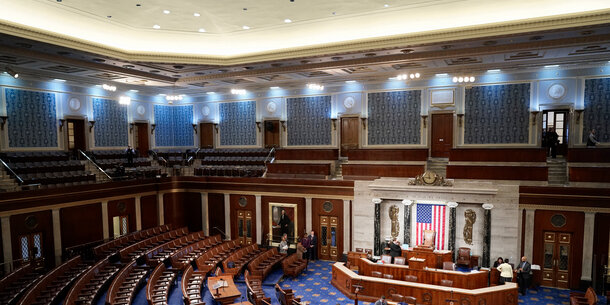Introduction
At the funeral service for Rep. John Lewis, President Barack Obama called on elected leaders to fulfill the civil rights legend’s vision of expanding and protecting our democracy for all Americans. He recognized the obstacles — partisan gerrymandering and a weakened Voting Rights Act among them — but insisted that we move forward to challenge failed practices and old policies that have stood in the way. “And if all this takes eliminating the filibuster, another Jim Crow relic, in order to secure the God-given rights of every American,” said Obama, “then that’s what we should do.” footnote1_UVKZ3rzY3jumLQfkeUhfDlEaQjt8sCshji5uLtGaT9s_m5pn8yyigAyn1 Max Cohen, “Obama Calls for End of ‘Jim Crow Relic’ Filibuster If It Blocks Voting Reforms,” Politico, July 30, 2020, https://www.politico.com/news/2020/07/30/barack-obama-john-lewis-filibuster-388600.
President Obama was right. The filibuster was designed and used for decades to thwart civil rights legislation. In recent years, its use and abuse has only grown. Sixty votes are routinely needed in the Senate for even the most minor matters, making it nearly impossible to legislate in the national interest or find common ground. An obstreperous minority has the ability to grind the Senate, and Congress more generally, to a halt. To a greater degree than is commonly realized, this is a relatively new phenomenon.
During the Obama administration, Senate Republicans took obstruction to a new level, using the filibuster more than ever in history. But the use of the tactic had been climbing even before Obama became president, prompting recent presidents of both parties to use executive orders and other administrative tools to circumvent Congress. The Senate is already minoritarian because of the overrepresentation of small and rural states in the body. For example, California, with 39 million people, gets two senators in Washington, the same as Wyoming, Vermont, and Alaska, each of which is home to fewer than a million people. footnote2_87SADqdKw120HTBnlQCoRPPHwTazUKRQokEAoEOS-mc_s0iFN3TCTpaf2 Jonathan M. Ladd, “The Senate Is a Much Bigger Problem Than the Electoral College,” Vox, April 9, 2019, https://www.vox.com/mischiefs-of-faction/2019/4/9/18300749/senate-problem-electoral-college. And by 2040, given projected population growth, two-thirds of Americans will be represented by just 30 percent of the Senate. footnote3_0QnehxNDoCBSUpuvVBQm27d6UL7–1NVZfZ4YstcqyU_hr2NiAVHDDf43 Philip Bump, “By 2040, Two-Thirds of Americans Will Be Represented by 30 Percent of the Senate,” Washington Post, November 28, 2017, https://www.washingtonpost.com/news/politics/wp/2017/11/28/by-2040-two-thirds-of-americans-will-be-represented-by-30-percent-of-the-senate/. Given that the executive branch has increasingly moved away from legislative initiatives because of Senate obstruction, the filibuster continues to undermine a real democracy.
Today, our country has urgent needs. The struggle for democracy and racial justice must be at the heart of our politics. Chief among these goals must be repair of our democratic systems, which, this pandemic has revealed, are so evidently in need of renewal. Millions of Americans are calling for major reforms to ensure our democracy continues to function — overhauling our elections, creating stricter ethics rules for elected and appointed officials, limiting the poisonous influence of money in politics, and ensuring that voters choose their elected officials rather than the reverse. These reforms will make our institutions responsive to the popular will.
Under current Senate rules, however, a minority can stymie efforts to fix our broken system. Not slow those reforms, not deliberate, not debate, but simply block them. For that reason, democracy advocates and their elected champions must demand that the filibuster be eliminated. If we are to take the steps that are urgently needed to save our democracy, we at long last must abolish the filibuster.
End Notes
-
footnote1_UVKZ3rzY3jumLQfkeUhfDlEaQjt8sCshji5uLtGaT9s_m5pn8yyigAyn
1
Max Cohen, “Obama Calls for End of ‘Jim Crow Relic’ Filibuster If It Blocks Voting Reforms,” Politico, July 30, 2020, https://www.politico.com/news/2020/07/30/barack-obama-john-lewis-filibuster-388600. -
footnote2_87SADqdKw120HTBnlQCoRPPHwTazUKRQokEAoEOS-mc_s0iFN3TCTpaf
2
Jonathan M. Ladd, “The Senate Is a Much Bigger Problem Than the Electoral College,” Vox, April 9, 2019, https://www.vox.com/mischiefs-of-faction/2019/4/9/18300749/senate-problem-electoral-college. -
footnote3_0QnehxNDoCBSUpuvVBQm27d6UL7–1NVZfZ4YstcqyU_hr2NiAVHDDf4
3
Philip Bump, “By 2040, Two-Thirds of Americans Will Be Represented by 30 Percent of the Senate,” Washington Post, November 28, 2017, https://www.washingtonpost.com/news/politics/wp/2017/11/28/by-2040-two-thirds-of-americans-will-be-represented-by-30-percent-of-the-senate/.




